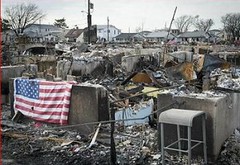 據美國國家海洋暨大氣總署(NOAA)氣象資料中心的數據顯示,美國2012年共歷經11次財物損失超過10億美元的極端天候與氣候事件。
據美國國家海洋暨大氣總署(NOAA)氣象資料中心的數據顯示,美國2012年共歷經11次財物損失超過10億美元的極端天候與氣候事件。
根據NOAA統計,共有7起惡劣天候或龍捲風事件,2起熱帶風暴及颶風、全年持續的乾旱以及伴隨而來的野火。這11起重大事件據信造成349人死亡。
珊迪颶風除了造成高達131人罹難(是所有事件死亡人數最高的),並因強風及沿海風暴導致東北各州(密蘇裏、德拉瓦、紐澤西、紐約、康乃狄克、麻州、羅德島)的嚴重損害,尤其是紐約州和紐澤西州;而當珊迪結合一個發展中的熱帶風暴後帶來的風、雨及大雪造成的損害更波及其他如北卡羅來納、維吉尼亞、西維吉尼亞、俄亥俄、賓州、新罕布夏等各州。珊迪在主要人口稠密區造成大範圍水電供給中斷。
夏季的熱浪和隨之而來的乾旱直接造成超過123人死亡,且根據NOAA的說法,由於熱力引發的額外死亡率仍難以估算。
2012年乾旱是美國自1930年代的乾旱後最嚴重的一次,乾旱全年影響全國超過半數的州(加州、內華達、愛達荷,蒙大拿、懷俄明、猶他、科羅拉多、亞歷桑那、新墨西哥、德州、北達科他、南達科他、內布拉斯加、堪薩斯、奧克拉荷馬、阿肯色、密蘇裏、愛荷華、明尼蘇達、伊利諾、印第安那、喬治亞州)。乾旱造成玉米、高樑及黃豆的歉收導致龐大的經濟損失,對美國中央農業各州尤為甚之。
2012年美國的野火燒掉了910萬畝地。從2000年來這是次高的數字,最高的數字發生在2006年燒掉了940萬畝地。多數受野火影響的州在美國西部(科羅拉多、愛達荷、懷俄明、蒙大拿、加州、內華達、奧勒岡、華盛頓州)。科羅拉多州的野火造成嚴重的金錢損失,如沃爾多峽谷(Waldo Canyon)的野火導致數百棟房屋被摧毀。
11項極端天候與氣候事件如下列:
- 2012年3月2-3日發生在東南部/俄亥俄河谷的龍捲風。
- 2012年4月2-3日發生在德州的龍捲風。
- 2012年4月13-14日發生在大平原的龍捲風。
- 2012年4月28日-5月1日發生在中西部俄亥俄河谷的惡劣天氣。
- 2012年5月25-30日發生在南部平原/中西部/東北的惡劣天氣。
- 2012年6月6-12日發生在落磯山脈/西南的惡劣天氣。
- 2012年6月29日-7月2日發生在平原/東/東北的惡劣天氣。
- 2012年8月26-31日颶風艾薩克的侵襲。
- 2012年夏天到秋天發生在西部區的野火。
- 2012年10月29-31日颶風珊迪的侵襲。
- 2012整年侵襲美國的乾旱/熱浪。
颶風珊迪及整年的乾旱對經濟的衝擊最嚴重,造成的損失至今仍在計算中。NOAA表示這兩項事件造成的損失需要數個月來完成估算。
NOAA估計這些逾10億美元災禍(billion-dollar disasters)造成的總損失將超越2011年,即便2012年的逾10億美元災禍個數較2011年來得少。
現有紀錄的年度災禍損失第一名是2005年。該年卡崔娜、麗塔、威爾瑪和丹尼斯颶風連番侵襲佛羅里達及墨西哥灣沿岸各州,造成超過1870億美元的損失,消費者物價指數調為2012美元。
綜觀全球,2012年氣候變遷導致北極海冰降到歷史新低;而南極洲一項新的研究發現,在西部南極大陸的冰蓋正以兩倍於過去認為的速度變暖。
南極氣溫50多年來升溫2.4℃
在南極西部冰蓋中心貝德科學站(Byrd Station)的溫度記錄顯示,自1958年以來,年平均氣溫顯著上升2.4℃。科學家們表示這個增幅為同期全球的平均溫度上升的3倍。
美國科學家們提出警告,氣候變遷將會越來越嚴重。美國國家大氣研究中心(NCAR)的科學家們11月發表由NASA資助的研究成果顯示:那些預測溫度將大幅上升的氣候模型比呈現微幅上升的模型來得精準。
NCAR科學家、報告撰寫人John Fasullo及Kevin Trenberth分析了精細的氣候模型如何再現熱帶及亞熱帶的相對濕度,藉此得出研究結論。Fasullo表示,「在關鍵地區的氣候模式如何模擬相對濕度、與對應二氧化碳增加而上升的溫度,兩者之間有顯著的關係;鑑於這些過程(processes)是全球氣候及雲系的根本,我們的發現認為,暖化現象應該處於目前預測範圍的高峰。」
In 2012, the United States experienced 11 extreme weather and climate events that cost more than $1 billion in losses, according to the National Oceanic and Atmospheric Administration’s Climactic Data Center.
NOAA counts seven severe weather and tornado events, two tropical storm or hurricane events, and the year-long drought and associated wildfires.
These 11 events combined are believed to have caused 349 deaths.
The most worst losses of life occurred during superstorm Sandy, which caused 131 fatalities. Extensive damage occurred across several northeastern states (MD, DE, NJ, NY, CT, MA, RI) due to high wind and coastal storm surge, particularly New York and New Jersey. Damage from wind, rain and heavy snow extended more broadly to other states (NC, VA, WV, OH, PA, NH), as Sandy merged with a developing Nor’easter. Sandy’s impact on major population centers caused widespread interruption to critical water and electrical services
The summer-long heat wave and associated drought caused over 123 direct deaths; in addition, NOAA says an estimate of the excess mortality due to heat stress is still unknown.
The 2012 drought is the most extensive drought to affect the U.S. since the 1930′s. Drought conditions have affected more than half the country for a majority of 2012: (CA, NV, ID, MT, WY, UT, CO, AZ, NM, TX, ND, SD, NE, KS, OK, AR, MO, IA, MN, IL, IN, GA). Drought impacts are most costly across the central agriculture states resulting in widespread harvest failure for corn, sorghum and soybean crops, among others.
Wildfires burned over 9.1 million acres across the U.S. in 2012. This is the second highest annual total since the year 2000, only exceeded by 2006 when 9.4 million acres burned. The most damaging wildfires occurred in the western states (CO, ID, WY, MT, CA, NV, OR, WA). Colorado experienced the most costly wildfires, such as the Waldo Canyon fire where several hundred residences were destroyed.
The eleven events include:
- Southeast/Ohio Valley Tornadoes – March 2–3 2012
- Texas Tornadoes – April 2–3 2012
- Great Plains Tornadoes – April 13–14 2012
- Midwest/Ohio Valley Severe Weather – April 28–May 1 2012
- Southern Plains/Midwest/Northeast Severe Weather – May 25–30 2012
- Rockies/Southwest Severe Weather – June 6–12 2012
- Plains/East/Northeast Severe Weather – June 29–July 2 2012
- Hurricane Isaac – August 26–31 2012
- Western Wildfires – Summer–Fall, 2012
- Hurricane Sandy – October 29–31 2012
- U.S. Drought/Heatwave – throughout 2012
Economic losses for two events – Sandy and the yearlong drought – are the big drivers this year in terms of costs and are still being calculated. NOAA says it will take months to develop a final, reliable estimate for each.
Given how big these events are likely to be, NOAA estimates 2012 will surpass 2011 in terms of aggregate costs for annual billion-dollar disasters, even with a smaller number of billion-dollar disasters this year.
The greatest annual loss to date was 2005 when Hurricanes Katrina, Rita, Wilma and Dennis struck Florida and the Gulf Coast states. That year costs exceeded $187 billion. All figures are CPI-adjusted to 2012 dollars.
Globally, climate change made itself felt in 2012 as Arctic sea ice shrank to a record low minimum extent and in Antarctica a new study finds that the western part of the continent’s ice sheet is experiencing nearly twice as much warming as previously thought.
The temperature record from Byrd Station, a scientific outpost in the center of the West Antarctic Ice Sheet, demonstrates a marked increase of 4.3 degrees Fahrenheit (2.4 degrees Celsius) in average annual temperature since 1958. Scientists say the rate of increase is three times faster than the average temperature rise around the globe for the same period.
U.S. scientists are worning that climate change is about to get worse. In November, scientists at the at the National Center for Atmospheric Research published a NASA-funded study demonstrating that climate model projections showing a greater rise in global temperature are likely to prove more accurate than those showing a lesser rise.
NCAR scientists John Fasullo and Kevin Trenberth, who co-authored the study, reached their conclusions by analyzing how well sophisticated climate models reproduce observed relative humidity in the tropics and subtropics.
“There is a striking relationship between how well climate models simulate relative humidity in key areas and how much warming they show in response to increasing carbon dioxide,” Fasullo said. “Given how fundamental these processes are to clouds and the overall global climate, our findings indicate that warming is likely to be on the high side of current projections.”
※ 全文及圖片詳見:ENS







